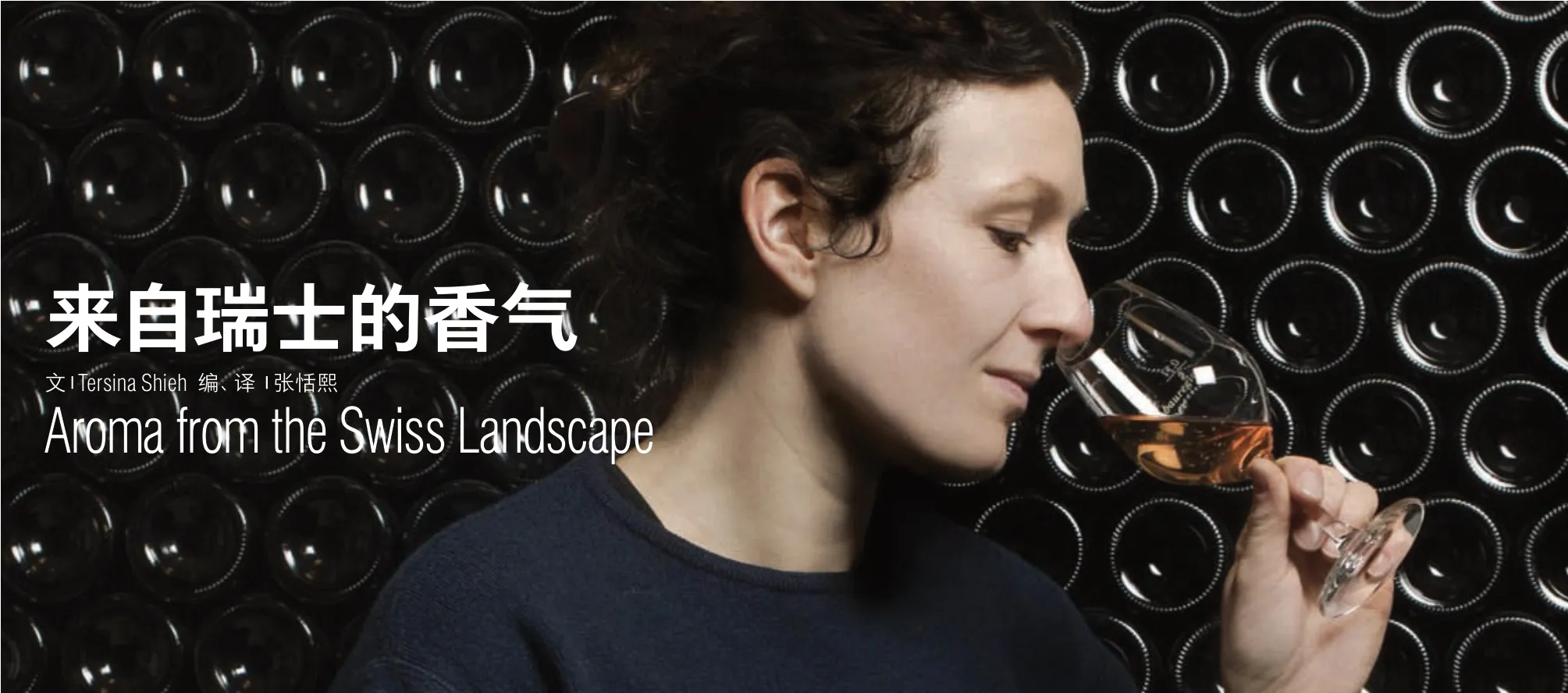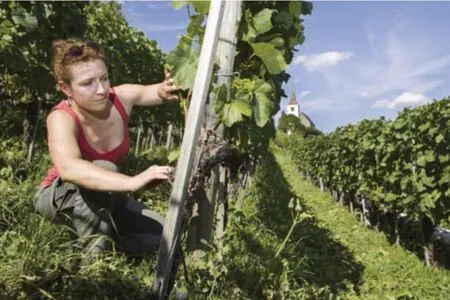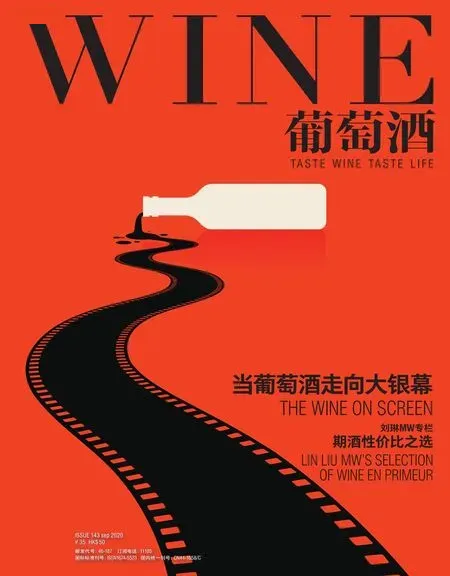来自瑞士的香气
文 Tersina Shieh 编、译 张恬熙

安妮·克莱尔·肖特不是一般的酿酒师。起初,她学习的是艺术史,并且不打算加入家族酒庄肖特·韦恩(Schott Weine)。她的祖父母和父母都在瑞士三湖泊区汝拉山麓的4公顷葡萄园中,酿造着传统的葡萄酒。
Anne-Claire Schott is not your average winemaker. She studied art history and did not plan to join the family wine estate, Schott Weine, where her grandparents and parents were making conventional wine with their 4 ha vineyard at the foothill of the Jura Mountains in the Three Lake region, Switzerland.
后来,安妮·克莱尔·肖特决定跟随她父亲的步伐。她在著名的桑冉葡萄栽培与葡萄酒酿造学院学习酿酒课程,之后在美国的一家大型酒庄里获得了丰富的经验。她还明确表示,自己可以经营这家企业,按照自己想要的方式酿造葡萄酒。
安妮·克莱尔曾说:“生于自然,勿毒害生息之壤。”因此,她在2016年加入公司后做的第一件事情,就是将葡萄园改造成生物动力法种植。她自称是葡萄酒栽培者而不是酿酒师。生物动力法耕种不允许出错,因此她花了大部分时间在葡萄园密切观察葡萄,以确保它们是健康的。毫不意外,她也是自然酒爱好者。她认为葡萄酒传达了文化、风景以及自然,可葡萄园和酒窖中的化学物质却剥夺了葡萄酒对于这些信息的传达。

安妮·克莱尔酿造了一个系列的自然酒,命名为Aroma der Landschaft(Aroma of the landscape),她让葡萄酒得以充分表现。这个系列的酒标是由一位当地艺术家设计而成,反映了她的理念。第一款酒是2017年的白葡萄酒,只使用种植在陡峭葡萄园尽头那一排排干墙旁的葡萄酿造。这是一款特别的混酿,用了6种葡萄一起发酵(莎斯拉、黑皮诺、灰皮诺、霞多丽、西万尼和长相思),但是安妮·克莱尔不想谈论品种。这款葡萄酒表现出特别的微气候,石头墙下的葡萄更容易暴露在太阳下。葡萄酒有宜人的花香和白色水果芳香,酸度清新且余味喜人。
安妮·克莱尔仍然在试验中,她用不同的方式来酿造葡萄酒,并且每年都会加入新的葡萄酒,以此来扩充“Aroma der Landschaft”这个产品组合。2018年是橙酒之年。经过3周的果皮接触以及在蛋形混凝土发酵罐中发酵,2018年份的白葡萄酒有额外的,以新鲜橘皮及茉莉花茶的结构。她还酿造出了一款2018年份的灰皮诺橙酒,进行了3周的果皮接触。这款酒有复杂的气味以及同样的茉莉花味道。一款独特的酒标将瓶子包了起来,展开就能看到与葡萄酒相关的信息。橙酒是用红酒的浸皮技术制成的白葡萄酒。它很适合用来搭配食物,因为它新鲜,有微妙的香味和结构。我觉得橙酒和中国菜搭配特别好。
目前,“Aroma der Landschaft”系列仅占酒庄葡萄酒产量的10%。安妮·克莱尔酿造的大部分葡萄酒仍然使用她父母肖特·韦恩的酒标。如果你问她和她父亲的葡萄酒有什么区别,安妮·克莱尔会告诉你:肖特·韦恩曾经的风格是传统和精致,而现在则是更加自由的风格,不同的年份有不同的诠释。那么她父母怎么看呢?她的父亲很高兴可以在酒庄帮忙,母亲则仍然在为员工们做饭。除了白葡萄酒和灰皮诺橙酒,安妮·克莱尔还酿造了一款轻起泡酒和蒙维黑皮诺。她认为传统葡萄酒都是一样的并且缺乏光泽。毫无疑问,我们会在市场上看到越来越多她的天然葡萄酒。
When she finally decided to follow her father’s footstep, she took winemaking course in the highly regarded Changins School of Viticulture and Enology before gaining experience in a large US winery. She also made it clear that she can run the business and makes wine the way she wants. ‘Living in nature, we cannot intoxicate the land’, said Anne-Claire. Therefore, the first thing she did when joining the business in 2016 was to convert the vineyards to biodynamic. She called herself a winegrower rather than winemaker. Biodynamic farming does not forgive mistake therefore she spends most time in the vineyard closely observing the grapes to make sure they are healthy. Not surprisingly, she is also a fan of natural wine. She believes wine conveys the culture, landscape and nature. Chemicals in vineyard and cellar rob the wine of being the messenger.
Anne-Claire created her own series of natural wine under the name ‘Aroma der Landschaft’ (Aroma of the landscape) where she allows the wines to fully express themselves. The label was designed by a local artist to reflect her philosophy. The first wine, Blanc 2017 was a white wine using only grapes grown next to the dry walls at the end of the rows on the steep vineyard. It is an unusual blend of six varieties fermented together (Chasselas, Pinot Noir, Pinot Gris, Chardonnay, Sylvaner and Sauvignon Blanc) but Anne-Claire doesn’t want to talk about varieties. The wine is about the special micro-climate under the stone walls where the grapes are more exposed to the sun. It has pleasant floral and white fruits aromas, fresh acidity and a savoury finish.

Still experimenting, Anne-Claire expands the ‘Aroma der Landschaft’ portfolio by making wine in a different way and adding new wine every year. 2018 was the year of orange wine. With three weeks skin contact and fermented in concrete egg, Blanc 2018 has extra dimension of fresh orange-peel note and jasmine tea structure. She also made a Pinot Gris Orange 2018 with three weeks skin contact. It has an intricate nose and the same jasmine tea palate. A unique lithography label wrapped around the bottle unfolds to review the information about the wine. Orange is white wine made with skin maceration red wine technique. It is food-friendly because of its freshness, subtle aromas and structure. I find it particularly great with Chinese cuisine.
At the moment, ’Aroma der Landschaft’ contributes only 10% of the total wine production. Most of the wine Anne-Claire made is still under her parents’ Schott Weine label. Asked if there is any difference between her father’s and her wine, Anne-Claire said Schott Weine was traditional and precise while now is more free style with different interpretation depending on the vintage. So what does her parents think? Father is happily helping out at the winery and mother still cooks for the staff.
In addition to Blanc and Pinot Gris Orange, Anne-Claire also makes a Pét Nat (a slightly fizzy sparkling wine) and Mon Vieux Pinot Noir. She reckons conventional wine is all the same and lacks spectrum. No doubt we will see more of her natural wine in the market.


